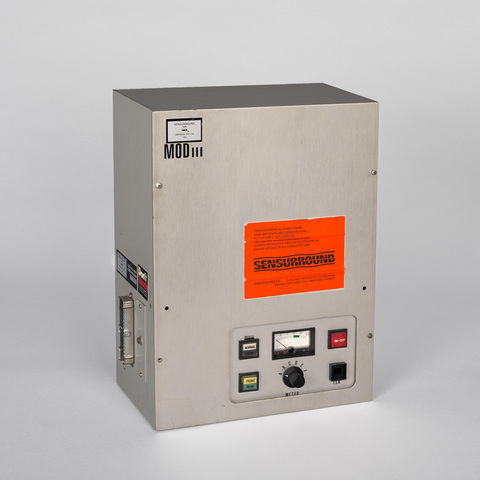Processeur son
Fiche détaillée
Type de l'appareil
processeur pour crééer des effets sonores de types vibrations dans le cadre de films à effets spéciaux (tremblements de terre, explosions, accidents), pour quatre types de pellicules : 1) 35 mm MagOptical avec trois channel stéréo sur trois pistes magnétiques et une piste optique Sensurround, 2) 35 mm Mag Optical avec une piste magnétique mono pour la musique, dialogues et bruits et une piste optique Sensurround, 3) 35 mm avec une piste optique contenant toutes les informations, 4) 70 mm avec six pistes magnétiques
Auteurs
Informations non disponibles
Fabricants
MCA
Los Angeles, Universal City, Californie
Utilisateurs
Informations non disponibles
Distributeurs
MCA
Los Angeles, Universal City, Californie
Sensurround B. V.
Amsterdam, Postbus 9258 W.3
Sujet du modèle
Informations non disponibles
Objectif
Informations non disponibles
Taille de l'objet
Ouvert :
Informations non disponibles
Fermé :
Longueur : 18.5 cm
Largeur : 32 cm
Hauteur : 41 cm
Diamètre :
Informations non disponibles
Taille de la boîte de transport
Informations non disponibles
Remarques
Marques : "Sensurround from MCA Universal City, CA. USA" ; "This equipment is leased from : Sensurround. Sensurround B. V. Postbus 9258 Amsterdam, W. 3. The Netherlands". A l'intérieur : "Sensurround. This control unit has been converted to Mod III - Model III A by J. M. Puttemans. 908 031".
"Developed by MCA and RCA under the guidance of former Universal City Studios sound department head Waldon O. Watson, the Sensurround Special Effects System, as it was billed on later releases, employed subaudible sound to create vibrations that made the audience feel the effects of earthquakes, explosions, crashes and the like. For 35 mm engagements, prints were offered in three different formats : MagOptical with three-channel stereo on three magnetic tracks and the Sensurround information on one optical track ; MagOptical with one magnetic track containing mono channeled music, dialogue and effets and one optical track containing the Sensurround information ; and single track optical containing all audio information. For 70 mm prints, six magnetic tracks were employed in the same manner as MegaSound. Sensurround changed with each feature even through the soundtrack pattern was followed as noted. For example, Earthquake had only rumbles in the Sensurround information ; Midway included rumbles and souns effects ; Rollerwoaster incorporated music into the Sensurround rumble along with sound effects ; and Zoot Suit, which introduced Sensurround Plus, utilized the full system plus Lightsurround, a synced light cueing system for in-auditorium effects. Feelarama, a variation of Sensurround, was utilized for the mid-1970s European reissue of Krakatoa East of Java, retitled Volcano. Another variation, called Vibrasound, was originally to have been employed on The Boat (Das Boot), but that film was released in the United States in Dolby Stereo only ; it is unclear if the rumble effects system was actually utilized elsewhere" (Robert E. Carr and R. M. Hayes, Wide Screen Movies, A History and Filmography of Wide Gauge Filmmaking, Jefferson and London, Mc Garland & Company, Inc., 1988, p. 249-250).
